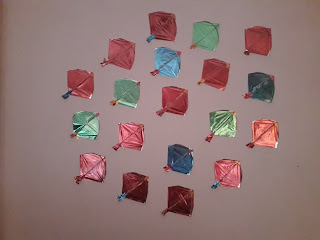Over the millennia, kites have been used to ward off evil, deliver
messages, represent the gods, raise banners, discover natural phenomena, propel
craft, drop propaganda leaflets, catch fish, spy on enemies, send radio
signals, measure the weather, photograph the Earth, and lift passengers
skyward.
Two monks, in particular, are considered to be responsible for bringing kites to India. The first is Fa-Hien, who travelled to India in the early 5th century in search of Buddhist texts. The second was Hiuen Tsang who arrived later, in the 7th century, and spent 17 years travelling and documenting India.
In India there is a belief associated with kites is that they serve as thanksgiving symbols to the gods as they breach into the heavens above. Over the years, the tradition of flying kites is performed by adhering to the procedure laid down by ancestors and has been taken very seriously.
Kites have become an expression of independence and a way of resisting colonial power over time and is still practiced today. On every Independence Day, the young and old congregate on rooftops of cities and engage in kite-flying competitions.
With the same flow the tradition kite festival was started. The tradition of kite flying during Makar Sankranti has ancient roots and is believed to have originated in the Indian subcontinent. Historical records suggest that kite flying was a popular pastime among the Mughal emperors also, and it gradually found its way into the cultural fabric of India.
It is celebrated as Uttarayan in Western India. The festival is marked by people flying kites from their terraces and rooftops and kite flying competitions. Kite flying is a tradition that is deep-rooted in Indian culture and the Kite festival is one that is eagerly awaited.
The International Kite Festival (Uttarayan) is one of the biggest festivals celebrated. Months beforehand, homes in Gujarat begin to manufacture special box kites for the festival. The festival of Uttarayan marks the day when winter begins to turn into summer, according to the Indian calendar.
The special significance attached to the celebration of Makar sankranti, is Kite Flying. The gods who are believed to have slumbered for six long months are now awake and the portals of heaven are thrown open! Uttarayan is celebrated all over Gujarat but the excitement is high at Ahmedabad, Surat, Nadiad and Vadodara.
Falling on the 14th or 15th of January every year, Uttarayan marks the end of the winter solstice and the beginning of longer, sunnier days. This festival is synonymous with kite-flying, delicious traditional foods, and a sense of unity and joy among people.
The kite flying festival in India falls on 14th of January every year, marking the arrival of spring and the transition of the sun into the Makara Rashi (the Capricorn zodiac sign). In quite a few states in India, Makar Sankranti is considered as a major harvest festival. India celebrates only one kite festival.
The biggest kite in India is the Patang, which is a traditional kite made of bamboo and paper. It can measure up to 10 feet in length and is usually flown during festivals such as Makar Sankranti.
Ahmedabad is often called the Kite capital of Gujarat. One of the best places to enjoy Uttarayan is by the Sabarmati Riverfront. With a capacity of over five hundred thousand, the area remains flooded with vibrantly coloured kites and smiling faces from as early as 5:00 in the morning.
Goals are what take us forward in life like a kite. As Kite remains on top, our goals in life must be on topmost priority. We need to hold our heads towards the kite while flying, similarly we must be focused towards our goals.




No comments:
Post a Comment